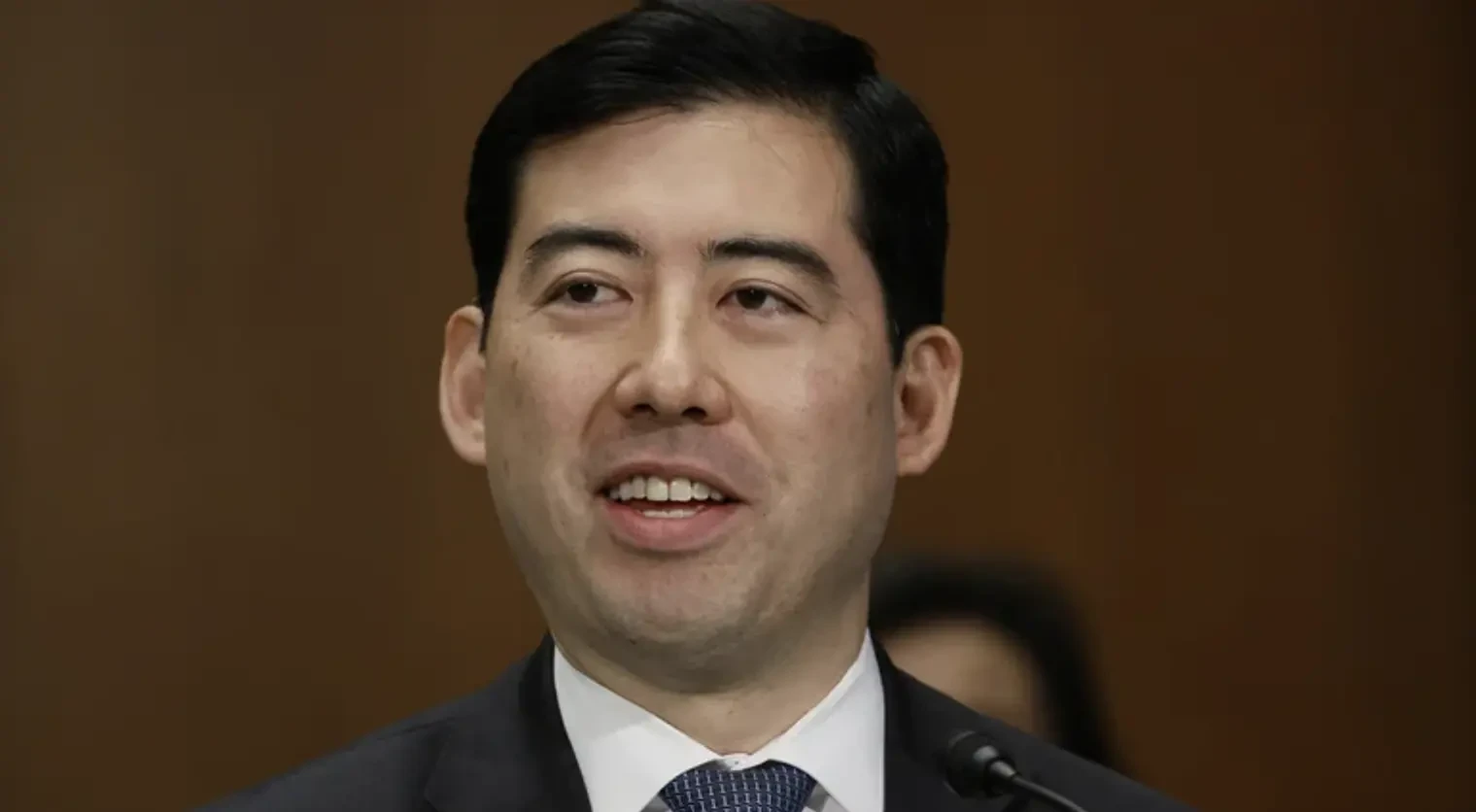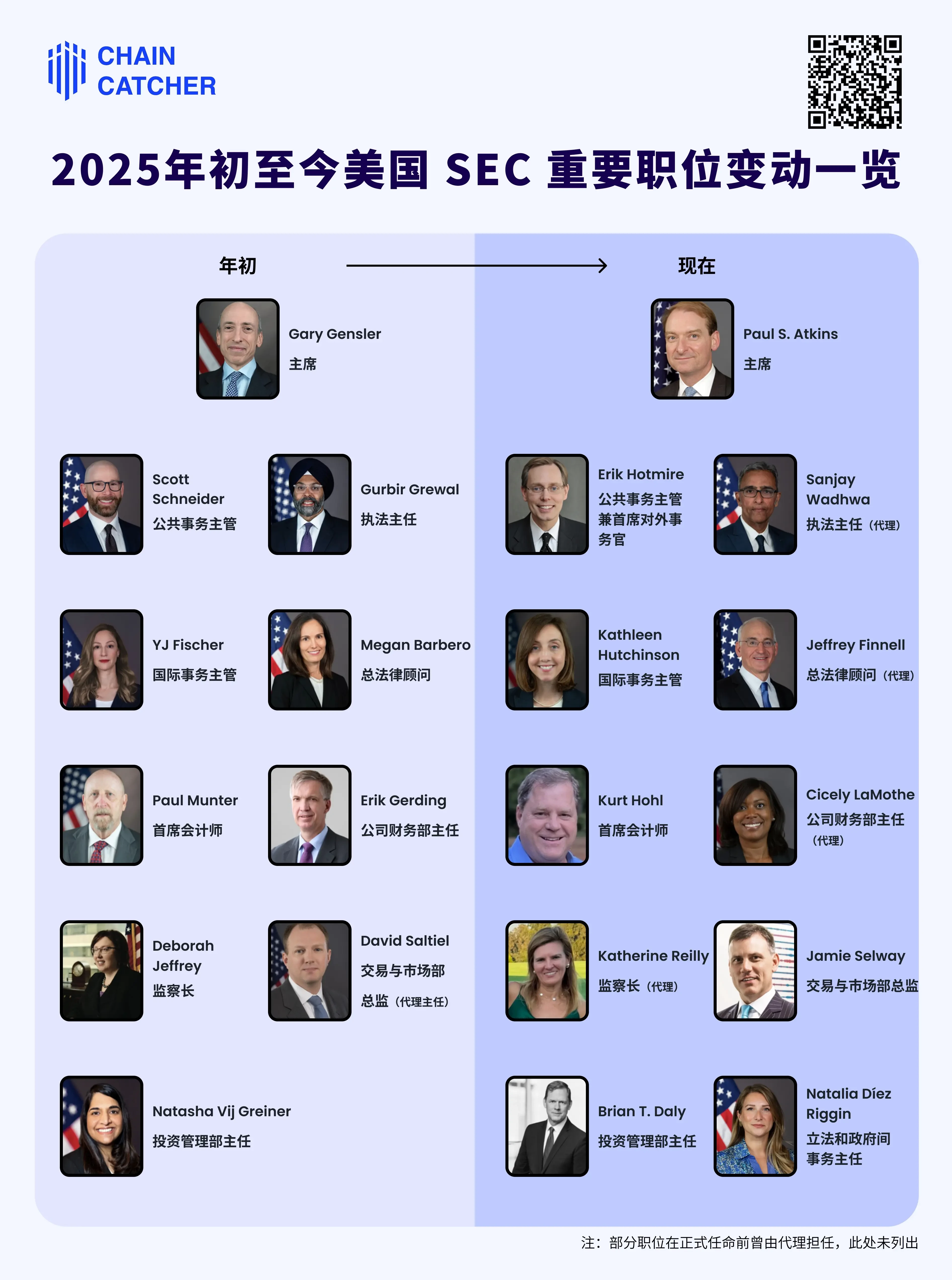Taking stock of the U.S. SEC’s personnel adjustments within half a year, is the “new” SEC really more crypto-friendly?
Original author: Fairy, ChainCatcher
Original editor: TB, ChainCatcher
Within half a year, several key executives were replaced, more than 500 people resigned, and departments were restructured… The U.S. Securities and 交換 Commission underwent drastic adjustments in the first half of 2025.
This internal storm is quietly reshaping the regulatory landscape of the 加密貨幣 market. This article will review the key changes made by the SEC over the past six months and analyze whether the “new” SEC has truly opened a friendly door to cryptocurrencies.
The third change of chairman has “adjusted” the rhythm of crypto regulation
In the first half of 2025, the U.S. Securities and Exchange Commission (SEC) experienced the replacement of three chairmen: Gary Gensler during the Biden administration, Acting Chairman Mark T. Uyeda, and current Chairman Paul Atkins. Unlike Gensler, who has a tough stance and frequently initiates enforcement actions, Uyeda and Atkins are both considered to be more friendly to the crypto industry.
Acting Chairman Mark T. Uyeda has always been open to cryptocurrencies, and he once cast a key vote in favor of the Bitcoin spot ETF. In just a few months as an agent, Uyeda quickly implemented the Trump administrations pro-crypto commitments: establishing a Cryptocurrency Task Force led by Hester Peirce; revoking the much-criticized SAB 121 accounting policy; and establishing a Cyber and Emerging Technologies Unit (CETU) to replace the old Crypto Assets and Network Department.

In April 2025, Paul Atkins officially took over as chairman of the SEC, further consolidating this shift in attitude. Atkins is no stranger to the crypto world: as early as 2017, he served as co-chairman of the 代幣 Alliance, a digital chamber of commerce, and actively promoted the formulation of industry standards for token issuance and trading. According to Fortune, Atkins holds about $6 million worth of crypto-related assets, including shares or other investments in crypto companies such as Anchorage and Securitize.
After taking office, Atkins has publicly expressed his crypto-friendly stance many times. He pointed out that the crypto market has been trapped in the SECs regulatory gray area for many years and promised to return to the fundamental mission of promoting rather than suppressing innovation during his tenure.

Major changes in core departments
In addition to the change of chairman, the core departments of the SEC also ushered in a number of key personnel adjustments. The following are the changes in important positions of the SEC since the beginning of the year:

Of the 10 executive changes, at least two new executives are believed to have experience in the crypto industry: Brian T. Daly, director of investment management, and Jamie Selway, director of trading and markets.
Brian T. Daly was previously a partner at the international law firm Akin Gump. In his official resume, digital assets, cryptocurrencies and blockchain are listed as his areas of expertise. Jamie Selway was a partner at Sophron Advisors and served as global head of institutional markets for the crypto company Blockchain from 2018 to 2019.
More importantly, the two departments they are in charge of are extremely important in the SEC structure. The Investment Management Department is responsible for regulating investment products and services including mutual funds, ETFs, closed-end funds, and registered investment advisors. The Trading and 市場s Department controls the operating rules of market infrastructure such as exchanges, market makers, brokers, and clearing houses. In other words, crypto ETFs and the crypto trading environment are affected by these two departments.
At the same time, the SECs enforcement department, a key power center, has also undergone a blood transfusion. Gurbir Grewal, the former director of the enforcement department who has long been tough on cryptocurrencies, left office in October 2024. During his tenure, he led a number of heavyweight crypto lawsuits, including Ripple and Coinbase. According to Cornerstone Research data, in 2024, the SEC initiated a total of 33 crypto-related enforcement actions, involving 90 defendants or respondents.
After Grewal left, Sanjay Wadhwa took over as acting director, and the enforcement efforts slowed down significantly. Between February and March of this year, the SEC withdrew lawsuits against several well-known crypto companies, including Coinbase, Consensys, Robinhood, Gemini, Uniswap and Kraken.
In addition, the SEC launched an employee buyout plan at the end of February, offering $50,000 in compensation to employees who voluntarily resigned. In the end, more than 500 people chose to retire early or resign, accounting for about 10% of the total number of employees in the institution. This wave of internal slimming also created space for subsequent structural reorganization and policy shifts.
Has the SEC’s “crypto rhythm” changed?
In terms of regulatory trends, the SEC is expressing its views through intensive meetings and policies. In the first half of this year, the SEC has held 6 roundtable meetings related to cryptocurrencies, covering core topics such as regulatory frameworks, custody mechanisms, asset tokenization, and DeFi.
At the regulatory level, it is also making progress. On May 30, the SEC issued a policy statement on PoS network staking activities, clarifying for the first time that three types of staking activities do not constitute securities issuance: including user self-staking, non-custodial third-party staking, and compliant custodial staking. This provides a clearer compliance path for current crypto staking services.
At the same time, ETF approvals began to accelerate. On June 11, the SEC sent notices to several institutions that planned to issue Solana spot ETFs, requiring them to resubmit a revised S-1 document within 7 days and promised to complete the review feedback within 30 days after submission.

With personnel changes, loosening of rules and softening of attitudes, this organization, which once made countless crypto projects walk on thin ice, is now re-dialoguing with the industry.
Supervision will not disappear, but future supervision may no longer be a high-pressure network, but a bridge to co-construction.
This article is sourced from the internet: Taking stock of the U.S. SEC’s personnel adjustments within half a year, is the “new” SEC really more crypto-friendly?
Original author: 100y Original translation: TechFlow Key Takeaways Visa and Mastercard are the two major operators of the global payment network. It is no exaggeration to say that they almost dominate the global payment market. It is estimated that the total global payment transaction volume will reach 20 trillion US dollars by 2024. If card payments can be processed through blockchain networks in the future, this will bring huge development opportunities to the blockchain and stablecoin industries. Although the front-end experience of todays payment system has been greatly improved due to the innovation of various fintech companies, the back-end system that actually processes transactions still relies on outdated technology. There are still many problems in settlement and cross-border payments, and blockchain provides an exciting solution to these problems. In April…






